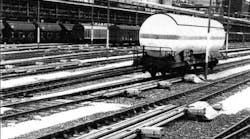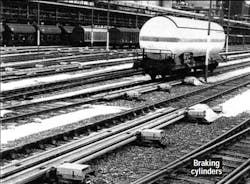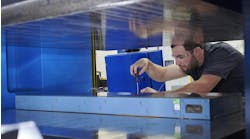The process of coupling rail cars together to assemble a train is called “humping.” In this process, an individual car is pushed over a small hill, or hump. As the car descends the other side of the hill, it coasts until it contacts another car and automatically couples to it. The multicar assembly is then pulled forward about one car length, and the process is repeated until an entire train is assembled. This all occurs in a marshaling yard, and the largest marshaling yards move thousands of rail cars every day.
An important parameter in car humping is speed. The car must be going fast enough to actuate the coupler, but excessive speed creates unnecessary shock that can damage components and freight. To control speed of the rail car, a jaw-type rail brake slows down cars, when necessary, before they contact the train segment already assembled. To accomplish this, a series of 10 to 12 brake actuators — each powered by a pneumatic cylinder — pushes on a moveable rail that presses against the inner surface of the car’s wheel flange to slow down the car.
The brakes are used for reducing and the speed of of rail cars. This is no easy task, considering the mass of the car — each wheel set can carry a load of 25 tons or more. Moreover, the relatively small surface area of wheel flanges requires high braking forces to be generated.
Furthermore, as with most railroad equipment, components of the rail brakes are constantly exposed to the weather and must perform repeatedly in the frigid cold, blistering heat, during heavy downpours, and while subjected to sand, dirt, ice, and other contaminants.
Composite wins out over bronze
After extensive product research and successful test results at a railway marshaling yard in Germany, rod bearings made of Orkot were installed in the track-mounted, jaw-type rail brakes. Orkot is a resin-impregnated and lubricated fine-weave fabric material from Trelleborg Sealing Solutions. The material is capable of withstanding high side loads, damping vibrations, and embedded foreign particles. Orkot Slydring prevents metal-to-metal contact between piston rod and gland bore and absorbs high transverse loads.
Conventional rail brake assemblies typically use bronze as the primary material for piston rod and linkage bearings. However, bronze must be regreased periodically to prevent wear between the rod or shaft and the bearing. Scheduled maintenance such as this robs productivity both in manpower required and downtime to perform the task. Furthermore, increasingly strict environmental laws may prohibit using grease in this type of application because lubricants eventually could work their way into groundwater.
These potential environmental problems prompted officials to find an alternative to the maintenance-intensive bronze bearings. They selected Orkot Slydring as a candidate for piston rod and linkage bearings for field testing because of its maintenance-free performance and positive environmental characteristics resulting from its self-lubricating feature.
During a four-year progressive testing period in the marshaling yard, Orkot Slydring bearings were installed in the rail brakes. They were pressed into each cylinder’s rod-end cap, and a small amount of lubricant was supplied initially. The lifetime self-lubrication significantly reduced scheduled downtime and labor costs over bronze bearings and exceeded expectations.
After successfully completing field tests, the bearings became standard equipment on all jaw-type rail brakes and retarders. As a result, arrival speed of the rail cars has been reduced from 8.5 m/sec (19 mph) to 4.5 m/sec (10 mph), a significant improvement that substantially reduces wear and tear on the rail equipment.


